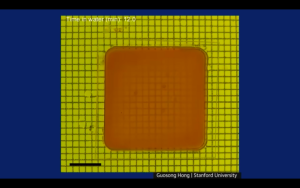
Researchers at Stanford University have stumbled upon a method of making biological tissue, such as skin, muscle and connective tissue, temporarily transparent, allowing the underlying organs to be viewed without the need for x-ray imaging or surgical procedures. The technique could not only one day allow for medical imaging that is even less invasive than x-ray or MRI procedures, but it is also simple to apply and reverse, and only uses a common food additive to produce its effect.
Although the technique has only been tested on rodents, the process that caused the test animals’ skin and muscles to become transparent was not only deceptively simple, it also involved the use of a common food dye: when a solution of tartrazine, also known by its label when used as an additive, FD&C Yellow 5, was topically applied to the skin of the test mice it caused ordinarily opaque tissues to become entirely transparent, allowing the researchers to “see its liver, small intestine, bladder and other organs down to the resolution of microns,” according to Axios. The same process, used in tandem with an imaging technique called laser speckle contrast imaging, was also used to view the blood vessels in the mouse’s brain.
In addition to tartrazine being considered safe for biological use and the transparency technique being no more complicated than applying the solution to the subject’s skin, the process is also completely reversible, with the effect disappearing after the solution is rinsed off.
The reason that our tissues appear opaque to begin with is because as light penetrates biological tissue it is scattered by the combination of water and microscopic components that make up the structures of our cells, with each component having a unique refractive index (RI), a function of the speed of light in that material in relation to a vacuum, of which in turn dictates how light bends as it passes through that substance.
The researchers theorize that the presence of the tartrazine solution is shifting the overall refractive index of the tissues by absorbing and re-transmitting the light at different wavelengths in a way that allows the light to pass through the tissues with a minimal of scattering, effectively making it transparent.
“The most surprising part of this study is that we usually expect dye molecules to make things less transparent,” remarked study co-author Guosong Hong, a Stanford University assistant professor of materials science and engineering.
“For example, if you mix blue pen ink in water, the more ink you add, the less light can pass through the water,” Hong explained. “In our experiment, when we dissolve tartrazine in an opaque material like muscle or skin, which normally scatters light, the more tartrazine we add, the clearer the material becomes. But only in the red part of the light spectrum. This goes against what we typically expect with dyes.”
“Looking forward, this technology could make veins more visible for the drawing of blood, make laser-based tattoo removal more straightforward, or assist in the early detection and treatment of cancers,” Hong said of potential medical uses for the technique.
“Instead of relying on invasive biopsies, doctors might be able to diagnose deep-seated tumours by simply examining a person’s tissue without the need for invasive surgical removal,” Hong added.
Subscribers, to watch the subscriber version of the video, first log in then click on Dreamland Subscriber-Only Video Podcast link.
This reminds me of the Pilot episode from the ‘Fringe’ TV series!
I have have just started watching Fringe in the last few weeks.